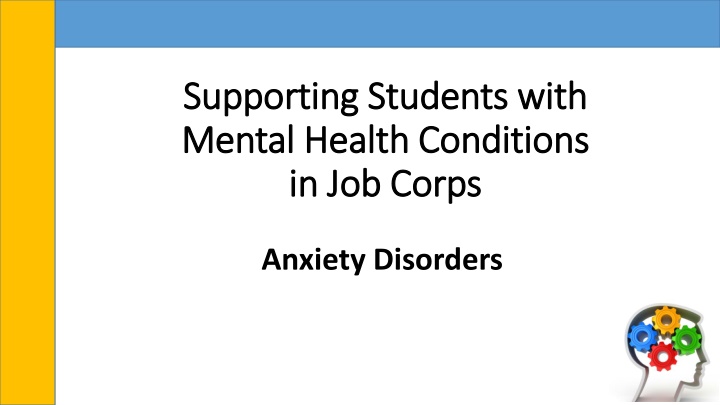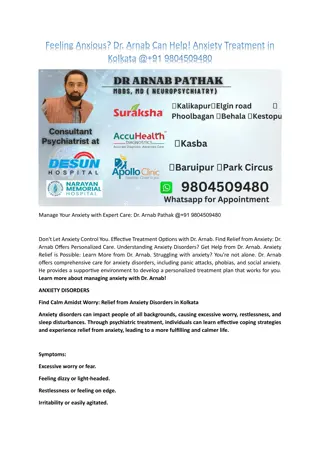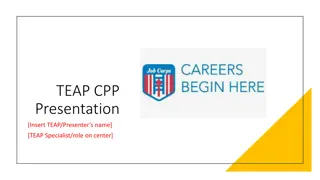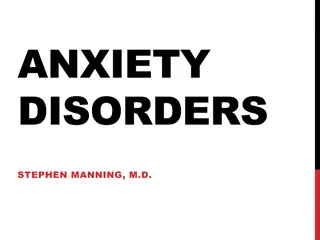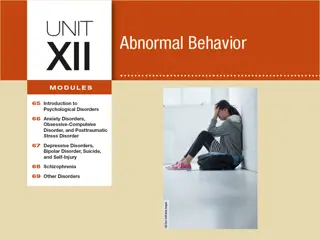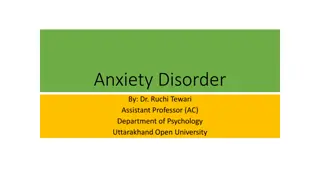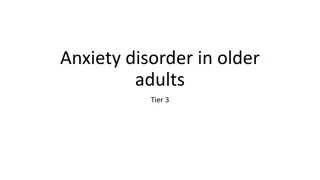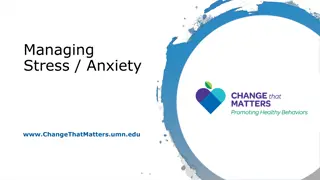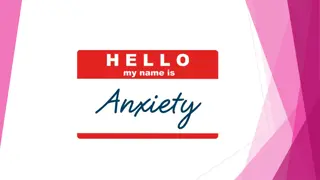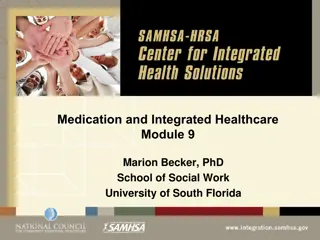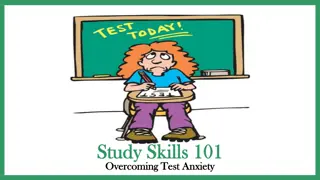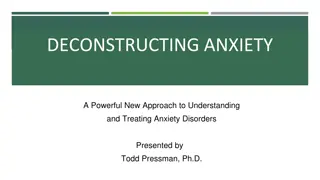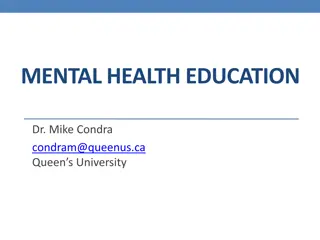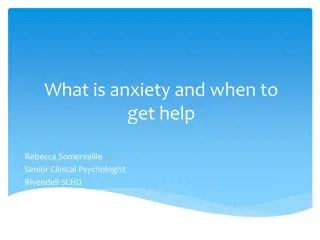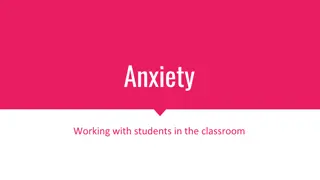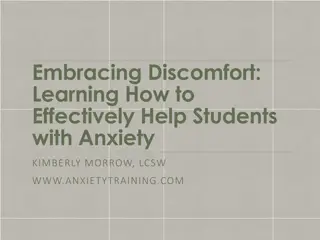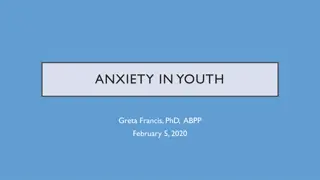Supporting Students with Anxiety Disorders in Job Corps: A Mental Health Presentation
Helena Mackenzie, PhD, LP, a Mental Health Specialist, delivers a presentation on anxiety disorders in Job Corps, focusing on diagnostic changes, clinical presentations, and evidence-based interventions. The presentation highlights the prevalence of anxiety disorders in Job Corps students and emphasizes the importance of addressing mental health conditions in this population to enhance overall wellness and academic success.
Download Presentation

Please find below an Image/Link to download the presentation.
The content on the website is provided AS IS for your information and personal use only. It may not be sold, licensed, or shared on other websites without obtaining consent from the author.If you encounter any issues during the download, it is possible that the publisher has removed the file from their server.
You are allowed to download the files provided on this website for personal or commercial use, subject to the condition that they are used lawfully. All files are the property of their respective owners.
The content on the website is provided AS IS for your information and personal use only. It may not be sold, licensed, or shared on other websites without obtaining consent from the author.
E N D
Presentation Transcript
Supporting Students with Supporting Students with Mental Health Conditions Mental Health Conditions in Job Corps in Job Corps Anxiety Disorders
Presenter Information Presenter Information Helena Mackenzie, PhD, LP Region 5 (Chicago) Mental Health Specialist 2
Learning Objectives Learning Objectives After this presentation, participants will be able to: articulate applicable changes to titles and diagnostic criteria for anxiety disorders based on DSM-5. recognize how clinical presentations for anxiety disorders may vary for adolescents and young adults. identify at least one evidence-based intervention for anxiety disorders, including panic attacks, social anxiety disorder, and generalized anxiety disorder 3
IN 15 IN 15- -18 Job Corps Health and Wellness Report 18 Job Corps Health and Wellness Report Program Year (PY) 2014 Program Year (PY) 2014 Mental health disorders account for 36% of medical separations Anxiety disorders account for 4.1 % of all medical separations Only Mood disorders accounts for more mental health related medical separations (18% of all) Increase from PY 12 which was 3.5 percent for anxiety disorders Average Length of Stay (ALOS) PY 2012, 206 days; PY 2013, 166 days; PY 2014, 151 days Anxiety disorders account for 5.2 percent of all students with disabilities (including all disability categories) 4
Diagnostic and Statistical Manual Diagnostic and Statistical Manual (DSM) 5 Overview (DSM) 5 Overview Anxiety Disorders 6
Anxiety Disorders in DSM 5 Anxiety Disorders in DSM 5 Separation Anxiety Disorder (previously under Disorders Usually First Dx in Infancy, Childhood, Adolescence ) Selective Mutism (previously under Disorders Usually First Dx in Infancy, Childhood, Adolescence ) Specific Phobia Social Anxiety Disorder Panic Disorder Agoraphobia Generalized Anxiety Disorder Substance/Medication-Induced Anxiety Disorder Anxiety Disorder Due to Another Medical Condition Other Specified Anxiety Disorder; Unspecified Anxiety Disorder 7
DSM DSM- -5 Changes in Classification 5 Changes in Classification Obsessive Compulsive Disorder (no longer included with anxiety disorders, but with Obsessive-Compulsive and Related Disorders) Posttraumatic Stress Disorder (no longer included with anxiety disorders, but with Trauma- and Stressor-Related Disorders) Sequential order of anxiety disorder chapter and these other two chapters in DSM-5 reflects the close relationships between these disorders 8
Key Features of Anxiety Disorders Key Features of Anxiety Disorders All share features of excessive fear/anxiety that impact behavior: Fear: emotional response to real or perceived imminent threat. Example: Hear a loud sound while walking alone at night Associated with autonomic nervous system arousal (fight/flight/freeze/faint); thoughts of immediate danger; escape behaviors Anxiety: anticipation of future threats Example: Interviewing for job or giving a presentation in a week Associated with muscle tension, vigilance in preparation for future danger, rumination, and cautious and avoidant behaviors 9
Features of Anxiety Disorders Features of Anxiety Disorders Differ from developmentally normative fear/anxiety: Excessive or persist beyond developmentally appropriate periods Clinician, taking culturally factors into account, determines if fear is excessive (out of proportion to situation) Differ from transient fear or anxiety (stress induced): Persistent last typically 6 months or more, although time criterion is general guide Often develop in childhood and tend to continue if untreated Most occur more frequently in females than males (approx 2:1) 10
Differentiating Between Anxiety Disorders: Differentiating Between Anxiety Disorders: Highly co Highly co- -morbid (often meet criteria for more than one) morbid (often meet criteria for more than one) Differ from each other based on what the fear, anxiety, or avoidance behavior is about and the associated thoughts/beliefs interactions that involve possibility of being scrutinized (fear of negative evaluation, embarrassed, rejected) Separation Anxiety: fearful/anxious about separating from attachment figure Panic Disorder: recurrent panic attacks, concern of having more panic attacks and/or avoiding situations or changing behavior in maladaptive ways to avoid panic attacks Selective Mutism: consistently not speaking in social situations (like school) when able to speak in other situations (home, with friends); highly co- morbid with social anxiety disorder. Agoraphobia: fearful/anxious about specific situations due to thoughts that escape is difficult/help not available if have panic attack. Leads to avoidance of situations. Specific Phobia: fearful, anxious or avoidant of a specific object or situation (spiders, heights, needles) Generalized Anxiety Disorder: persistent/excessive worry and anxiety in different areas (work/home/school), find it hard to control worry, have specific physical symptoms. Social Anxiety: fearful or anxious about social 11
Case Study: Jacky Case Study: Jacky Referred by instructor because withdrawn and anxious; frequently leaves classroom suddenly looking like deer in headlights; becomes agitated if instructor tries to stop her Frequently coming to wellness complaining of racing heart, chest pain, feeling dizzy, and shaking. Medical work up is normal. Refusing to go to cafeteria because had symptoms before while eating lunch and scared they ll return. Also refusing to go to recreation because had episode while exercising Tells CMHC symptoms started a few months ago, come on quickly and then pass, but terrified will return and wants to leave JC because feeling overwhelmed 12
Poll: Most Likely Diagnosis? Poll: Most Likely Diagnosis? Separation Anxiety Disorder Generalized Anxiety Disorder Panic Disorder Specific Phobia Selective Mutism 13
Panic Disorder Panic Disorder 1)Recurrent, unexpected panic attacks abrupt surge of intense fear, discomfort that reaches peak within minutes. 4 or more symptoms: pounding heart, sweating, trembling, shortness of breath, choking sensation, chest pain, nausea, dizziness/lightheaded, derealization (feeling of unreality) or depersonalization (detached from oneself), fear of losing control/going crazy/dying. 2) At least one attack followed by month or more of either: persistent worry about another attack; and/or significant change in behavior (avoiding exercise or unfamiliar situations, etc) 14
Panic Disorder Panic Disorder Median age onset 20-24 years old; clinical presentation in adolescents same as adults Frequent school, work absences, and trips to ED, which can lead to dropping out school, losing jobs. Associated with agoraphobia, depression, social phobia, bipolar, alcohol use disorder Changes to DSM-5: deleted different types of panic attacks (situationally bound/cued, situationally predisposed, unexpected/uncued has been replaced with unexpected and expected ) Agoraphobia separated (see next slide) Panic attacks (not disorder) can occur as part of other conditions (PTSD, depressive disorder, alcohol use disorders). Can use a Panic Attack specifier, meaning panic occurs but doesn t meet panic disorder criteria and is part of another disorder. 15
Agoraphobia Agoraphobia Marked fear or anxiety about two (or more) situations public transit; open spaces; enclosed places; being in crowd; being outside home alone Fear and avoidance due to thoughts that escape difficult/help unavailable if panic or other embarrassing symptoms occur Situations almost always cause fear/anxiety and are actively avoided or require company of companion; cause clinically significant distress or impairment in social, occupational, other functioning Changes in DSM-5 Panic Disorder and Agoraphobia are unlinked two separate diagnoses, with distinct criteria Fear, anxiety, avoidance is persistent (six months or longer) Fear, anxiety is out of proportion to actual danger posed (judged by clinician) CAN diagnose agoraphobia in absence of panic disorder 16
Case Study: Juan Case Study: Juan Hasn t connected with peers, won t make eye contact Withdrawn and appears uncomfortable around adults and peers Having difficulty in classroom because refuses to participate in class and appears embarrassed and shuts down if called on Told counselor thinks people are judging him and is anxious about doing something embarrassing and not fitting in Feels nauseous, hands shakes, blushes, and has butterflies when knows he has to interact with people Struggled with same symptoms in high school so dropped out 17
Poll: Most Likely Diagnosis? Poll: Most Likely Diagnosis? Separation Anxiety Disorder Generalized Anxiety Disorder Specific Phobia Selective Mutism Social Anxiety Disorder 18
Social Anxiety Disorder Social Anxiety Disorder Marked fear/anxiety in one or more social situations where exposed to possible scrutiny of others: social interactions (conversation, meeting new people); being observed (eating, drinking), performing in front of others (speech) For children/adolescents MUST occur in peer settings, not just with adults Fear that will act in way or show anxiety and be negatively evaluated (embarrassed; rejected by others) Social situations almost always cause fear/anxiety Changes to DSM-5 Deleted requirement that adults recognize fear/anxiety as excessive For all ages, added duration of 6 months or more Deleted generalized specifier and replaced with performance only specifier 19
Social Anxiety Disorder Social Anxiety Disorder Median age onset in US is 13 (75% onset is between 8 and 15) Onset may follow an embarrassing or stressful experience (bullying, fainting during speech) Adolescents often have broader pattern of fear and avoidance (dating) Associated with elevated rates of school dropout and employment difficulties 20
Case Study: Nicole Case Study: Nicole Referred to wellness by RA because of difficulty falling asleep Reports feeling fatigued, muscle tension, and restless Difficulty in classroom because can t concentrate worrying about family, fearful won t be successful getting GED, can t stop thinking that will fail at everything, worried won t fit in, feels incompetent always been a worrier, can t stop worrying 21
Poll: Most Likely Diagnosis? Poll: Most Likely Diagnosis? Separation Anxiety Disorder Generalized Anxiety Disorder Specific Phobia Social Anxiety Disorder Panic Disorder 22
Generalized Anxiety Disorder (GAD) Generalized Anxiety Disorder (GAD) Excessive anxiety and worry ( apprehensive expectation ), which occurs more days than not for at least six months, about a number of events or activities Difficulty controlling the worrying Anxiety/worrying associated with at least three of following six symptoms (only one for children/adolescents): Restlessness Easily fatigued Difficulty concentrating/mind going blank Irritability Muscle tension Sleep problems Causes clinically significant distress or impairment 23
Generalized Anxiety Disorder (GAD) Generalized Anxiety Disorder (GAD) Median age of onset is 30, but most report always been anxious (rare diagnosis prior to adolescence) Approximately 2x as many females as males In adolescents anxiety often focuses on school performance or sports, even when not being evaluated by others 24
Case Study: Fernando Case Study: Fernando Referred to wellness because appears withdrawn and sad Reports having headaches and stomachaches since arriving at Job Corps five weeks before Frequently calling home Constant worry that his mother and brother have been in a car accident or something bad has happened (but calls home and they re fine) Wants to leave Job Corps to make sure family stays safe (mother reports family is safe, she has no worries about safety) Reports prior to coming to JC, he refused to sleep or go away from home due to fear something bad would happen if separated from family 25
Poll: Most Likely Diagnosis? Poll: Most Likely Diagnosis? Agoraphobia Panic Disorder Generalized Anxiety Disorder Separation Anxiety Disorder Selective Mutism 26
Separation Anxiety Disorder Separation Anxiety Disorder Developmentally inappropriate and excessive fear/anxiety about separation from attachment figures, including at least 3 of following: Recurrent, excessive distress when anticipating/experiencing separation from attachment figure Persistent/excessive worry about experiencing event (illness, accident, kidnapping) causing separation from attachment figure Persistent reluctance/refusal to go out, away from home due to fear of separation Persistent, excessive fear of being alone without attachment figure Repeated nightmares related to themes of separation Repeated physical complaints (headache, stomachache, nausea) when separation form attachment figures is anticipated or occurs Lasts at least 4 weeks (kids/adolescents); 6 months or more in adults 27
Separation Anxiety Disorder Separation Anxiety Disorder Previously only diagnosed in childhood with 12 month prevalence in children 4% (in adolescents-1.6%; adults 0.9%-1.9%) in US Equal ratio male/female in clinical sample Most commonly starts in childhood, but can occur in adolescence or adulthood Adolescents may worry about separation from dating partners May develop after life stress (loss, move, trauma) 28
Supporting Students With Anxiety Disorders in JC Supporting Students With Anxiety Disorders in JC Develop Chronic Care Management Plan Education around diagnosis (e.g. fact Sheet for Anxiety see next slide) Referral to groups on center (relaxation, mindfulness, peer support, etc) Support plan with counselors, residential staff, others Consider short term therapy sessions with CMHC Consider referral for medication management Would student benefit from longer term therapy at community clinic? What else might you do? 29
Supporting Students with Anxiety Disorders in JC Supporting Students with Anxiety Disorders in JC Does the student have a disability? If yes, have DC enter student into disability database Hold Reasonable Accommodation Committee (RAC) meeting with DC, CMHC, and student (and other staff as needed) to discuss and document accommodations Accommodations are adjustments to policies, practices or procedures. They are changes to how things are typically done, which allow an individual with a disability to perform or participate (they even the playing field ) things like adjusting a schedule to allow a student to attend off center appointments; special transportation to attend appointment off-center See JAN for sample accommodations for anxiety disorders (https://askjan.org/) 31
Evidence Based Interventions for Evidence Based Interventions for Anxiety Disorders Anxiety Disorders Brief Overview 32
Evidence Evidence- -Based Options for Anxiety Based Options for Anxiety Cognitive Behavioral Therapy (CBT) Acceptance and Commitment Therapy (ACT) Medication (This is NOT an exhaustive list of all of the evidence based treatments for anxiety, but a sampling of a few) 33
Cognitive Behavioral Therapy (CBT) Cognitive Behavioral Therapy (CBT) Well-establish, highly effective, time limited therapy Psychoeducation (about anxiety and CBT approach) Physical/somatic management skills training (how to self-monitor anxiety, muscle relaxation, diaphragmatic breathing, imagery, etc) Cognitive (identify negative thoughts, learn to challenge, identify positive self-talk, identify realistic expectations) Exposure (gradual imagined and in vivo exposure to feared situations to desensitize) Social Skills Training/assertiveness/nonverbal skills training (often part of CBT for anxiety disorders) CBT can be done individually or group format 34
Acceptance and Commitment Therapy (ACT) Acceptance and Commitment Therapy (ACT) Evidence based intervention for anxiety ( third wave therapy ) Goal is to increase psychological flexibility (be able to live fully, in touch with present moment, and modify behavior based on actual experience and long term values) Mindfulness skills Acceptance: willingly experiencing things as they are (e.g. painful feelings) Cognitive defusion: untangling self from thoughts (step back and see thoughts as thoughts, not truth ) Contact with present-moment: being present in here and now experience Self-as context: the self that is more than all experiences added together (observing self across time) Values clarification and committed action ACT can be done individually or in groups 35
Medication for Anxiety? Medication for Anxiety? Mild anxiety: consider evidence based therapy alone Moderate to severe anxiety: medications may help relieve acute anxiety and allow more effective therapy Severe anxiety: combination of evidence based treatment (such as CBT, ACT) and medication may be most helpful First line medications for anxiety are typically SSRIs Anxiety tends to recur once medication stopped without therapy 36
Main References: Main References: American Psychiatric Association (2013). Diagnostic and statistical manual of mental disorders, (5th ed.). Washington, DC. American Psychiatric Association. American Psychiatric Association (2013). Highlights of changes from DSM-IV-TR to DSM-5. Arlington, VA: American Psychiatric Publishing. Retrieved from http://www.dsm5.org/Documents/changes%20from%20dsm-iv-tr%20to%20dsm-5.pdf from dsm-iv-tr to dsm-5.pdf. Accessed July 18, 2016 Arch, J., Eifert, G., et al (2012). Randomized Clinical Trial of Cognitive Behavioral Therapy Versus Acceptance and Commitment Therapy (ACT) for Mixed Anxiety Disorders. Journal of Counseling and Clinical Psychology, Voll. 80, No. 5, 750-765. Hoffman, S., Asnaani, A., et al (2012). The Efficacy of Cognitive Behavioral Therapy: A Review of Meta-Analyses. Cognitive Therapy Research, 36 (5): 427-440. Roye-Byrne, P., Craske, M., et al (2010). Delivery of Evidence-Based Treatment for Multiple Anxiety Disorders in Primary Care. Journal of the American Medical Association, 303 (19): 1921-1928. Silove, D., Rees, S (2014). Separation Anxiety Disorder Across the Lifespan: DSM-5 Lifts Age Restriction on Diagnosis. Asian Journal of Psychiatry, 11: 98-101. Starcevic, V (2014). Classification of Anxiety Disorders: Changes, Conundrums and Consequences. Australian & New Zealand Journal of Psychiatry, 48 (12): 1164-1165. 37
